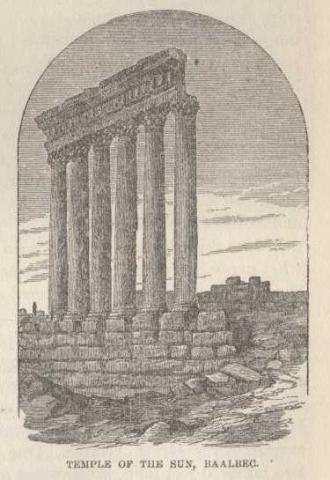












September 13, 1867, Sam and companions broke camp at Temnin el Foka and rode to Baalbek, then turned south and rode to Sirghaya. Mark Twain Project: Quaker City Itinerary
Ian Strathcarron wonders why Baalbek (Baalbec) was included in the Quaker City Excursion tour as it was not a Christian site but was the Roman Empire's "most sacred site of pagan worship". But then Twain did not know it was Roman and could not imagine how it could have been built by mere humans. "The Temples of Jupiter and Bacchus are still standing, just about, and the one to Venus still has its substructure in place. The Temple to Mercury, built on an adjacent hill, has all but disappeared. Later local gods were incorporated into the worship there."
Strathcarron goes on to remark that 30 years after Twain's visit "Kaiser Wilhelm II visited the site and, like everyone before and since, was overwhelmed by the scale of the endeavor. He bought permission from the Ottoman Sultanate to excavate the site, a task since taken over by teams from France as a part of the spoils of the First World War." According to Strathcarron, the site has been used for worship since 9000 BC, Alexander the Great passed through in the mid 330s BC and the Greco-Roman construction began. Two hundred years later Pompey ordered the greatest amount of building on the site. "The temples took 120 years to build and were only finished when Nero was emperor, in around 60 AD." He also notes that what Twain called The Temple of the Sun is now known as the Grand Court and what he called the Temple of Jupiter is now know as the Temple of Bacchus.
History. Ba'albek is the Heliopolis of Græco-Roman authors, but we possess no written records regarding the city earlier than the 3rd or 4th cent. of our era. The Greek name suggests that the place was connected with the worship of the sun, and Baal corresponds generally with the sungod. Coins of Heliopolis as early as the 1st cent. show that the town was a Roman colony. Coins of Septimius Severus (193-211), however, no longer bear the earlier device of a colonist with an ox, but the outlines of two temples. This confirms a statement dating from the 7th cent, to the effect that Antoninus Pius erected a large temple to Jupiter at Heliopolis in Phœoenicia, which was regarded as one of the marvels of the age. Later coins also bear representations of the two temples , but It is unknown whether the larger was ever finished. From the votive inscriptions of Antoninus Pius it would appear that the larger temple was dedicated to all the gods of Heliopolis; the smaller would, therefore, be the temple of Baal. Both temples most probably date from the same period. The vestibule was begun by Caracalla (211-217) and completed by Philip (244-249), who also built the winding staircase in front and the external walls. Besides Baal Venus was also specially revered at Heliopolis. Constantine is said to have erected a basilica here. Both before and after Constantine the Christians were persecuted at Heliopolis. Theodosius the Great (379-395) destroyed the great 'Trilithon' Temple at Heliopolis and converted it into a Christian church. At a later period bishops of Heliopolis are mentioned. Ba'albek was conquered by Abu `Ubeida on his march from Damascus to Homs. The Arabs extol the fertility of the environs, and attribute the antiquities to Solomon. The Arabic name corresponds with the earlier Syrian appellation of the place, Ba’aldach. The Arabs mention Ba'albek specially as a fortress, and at an early period they converted the acropolis into a citadel. As a fortress it was important in the wars of the middle ages, as, for example, in the conflicts between the Seljuks and the sultans of Egypt. In 1139 the town and castle were captured by Emir Zenghi, and during the same century the place suffered from several earthquakes. In 1175 the district of Ba'albek came into possession of Saladin. In the following year the Crusaders under Raymund made an expedition from Tripoli to the neighbourhood of Ba'albek, defeated the Saracens, and returned laden with booty. Baldwin IV. undertook a similar expedition from Sidon. In 1260 Ba'albek was destroyed by Hûlagû, and was afterwards conquered by Timûr. In the middle of the 16th cent. the ruins of Ba'albek were rediscovered by Europeans, but they have again suffered severely from earthquakes, particularly from that of 1759.
Ba'albek has obtained a world-wide celebrity. The magnificence of its ruins has excited the wonder and admiration of every traveller who has been privileged to visit it. Its temples are among the chefs-d’œuvre of Grecian architecture. For gorgeousness of decoration, combined with colossal magnitude, they stand unrivalled. The temples of Athens may surpass them in strict classic taste and purity of style ; but they fall far short of them in dimensions The wonderful structures of Thebes exceed them in ‘magnitude ; but with the symmetry of their columns, and the richness of their sculptured friezes and doorways, they bear no comparison. The substructions of the Great Temple are themselves entitled to rank high among the wonders of the world. Stones.upwards of 60 ft. long by 13 ft. broad are employed in its construction, and have been raised to a height of more than 20 ft. !
